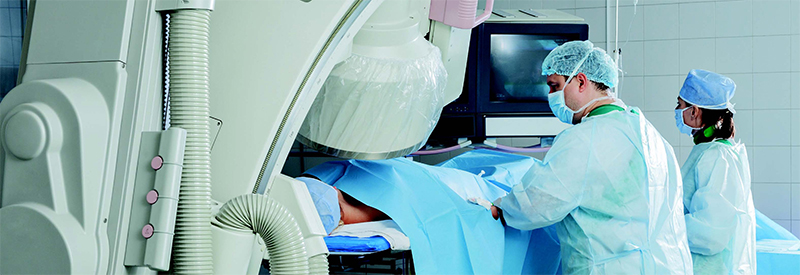New ABR Certificate Represents Historic Transition for Interventional Radiology
The recently approved Interventional/Diagnostic Radiology (IR/DR) certificate is progressing faster than expected, with the first IR/DR oral exam planned for 2017


The American Board of Medical Specialties (ABMS) approved the IR/DR certificate to recognize IR as a unique medical specialty in 2012. At that time, the first match between applicants and programs was not expected until 2017, but close work between radiologists and professional societies enabled the date to be moved up a year.
“Already, 20 programs have been approved and seven went into this year’s match in March. None of us in IR expected that,” said John A. Kaufman, M.D., M.S., director of the Dotter Interventional Institute at the Oregon Health & Science University in Portland and past chair of of the ABR-Society of Interventional Radiology (SIR) Primary Certificate Task Force. “We’re way ahead of schedule.”
“When people first heard of this, it sounded daunting,” said Matthew A. Mauro, M.D., chair of the Department of Radiology at the University of North Carolina School of Medicine in Chapel Hill, N.C., where he also holds the Ernest H. Wood Distinguished Professorship. “Now that we’ve had a few years with a lot of public relations work and talks at the society level, people have embraced it and we’re really on a roll,” said Dr. Mauro, who is also the RSNA Board of Directors liaison for information technology and annual meeting and serves on the ABR Board of Governors.
An Important Step for Interventional Radiology
The new IR/DR certificate joins diagnostic radiology, radiation oncology and medical physics as one of four primary certificates offered by the ABR. As such, it represents an important step for a specialty that has grown in reach and complexity since vascular radiologist Charles Dotter, M.D., performed the first angioplasty in 1964. A one-year fellowship in vascular and interventional radiology (VIR) was created in the 1990s, but as the years passed, the short duration of the fellowship and heavy emphasis on the procedural aspects of IR became increasingly viewed as inadequate to meet the demands of the profession.
“For 15 to 20 years, the interventional radiology community has recognized that our training needed more non-procedural components than had originally been envisioned,” Dr. Kaufman said. “The first certification in VIR took place in 1994, and by 2000 we were already looking at new training alternatives.”
“The major impetus behind the IR/DR certificate was to develop an improved curriculum to meet the needs of IR in the present and future,” Dr. Mauro said. “The current model offers only 12 months of training, which is not enough for the longitudinal experience of patient follow up.”
SIR first proposed primary certification in 2007. After ABR approval, IR leaders approached ABMS on two occasions (2009 and 2012) where, as Dr. Kaufman recalled, they were able to allay concerns about a “land grab,” or an expansion in the scope of the practice.
“The new certificate did not expand the scope of practice for IR, which was very important when we went to ABMS for approval,” he said. “All that has changed is the length of training and the emphasis on non-procedural patient management.”
The new plan offers two IR residency formats: a five-year Integrated Program and a two-year Independent Track. The Integrated IR Residency is available to medical students who apply through the National Resident Matching Program (NRMP) Main Match and begin residency training in the postgraduate second year. The curriculum is concentrated on DR in the first three years and IR in the last two.
The Independent IR Residency, available to graduates of a DR residency, is two years in length.
“The new format is designed to be as flexible and inclusive as possible,” Dr. Kaufman said. “It will accommodate students who might be coming out of medical school and those starting in DR who want to transition into IR.”
The training requirements leading to the new certificate in IR/ DR will be more rigorous compared to those of the subspecialty in VIR, Dr. Mauro said. There will be additional training in IR, critical care medicine and periprocedural care.
First IR/DR Oral Exam Will be Held in 2017
The Accreditation Council for Graduate Medical Education (ACGME) approved the first group of IR Integrated Residency programs in November 2015. NRMP assigned unique match numbers for each of these programs and made them eligible to participate in this year’s Main Residency Match for IR. Many other programs will receive accreditation in the coming months, but notification will be too late to allow for 2016 participation.
“A handful of programs have been approved to enter the Match for this year, and next year we expect that significantly more programs will participate in the Main Residency Match,” Dr. Mauro said.
“One thing that is very exciting is that programs that have not had IR fellowships have created new slots for this specialty,” Dr. Kaufman said. “That tells us the program is appealing to people.”
Graduates of an IR Residency will qualify to take the IR/DR examination offered by the ABR. The examination structure includes a DR Core Examination in month 36 of training and a certification exam that includes computer-based and oral examinations three months after training is completed.
“The IR/DR exam will be longer and more involved than the DR exam because there are two competencies being tested,” Dr. Kaufman noted. “Everyone will take the same core exam for diagnostic competency, while the oral component will take care of IR procedural competency.”
The first IR residents could graduate and sit for the IR/DR certificate examination as early as 2018 if current R3 residents transfer to the IR residency this summer, Dr. Kaufman said, explaining that the program does not allow external transfers. However, 2017 graduates of VIR fellowships will take the IR/DR oral examination, and those will be the first IR/DR certificates awarded.
Radiologists who hold a subspecialty certificate in VIR will be given IR/DR certificates at no additional cost if Maintenance of Certification (MOC) requirements, likely including practice quality improvement projects in IR, are up to date, Dr. Kaufman said.
VIR Fellowship to be Phased Out
The DR certificate will continue to be offered, and trainees currently enrolled in VIR fellowships will be able to complete their training and seek certification according to the processes now in place. Students interested in practicing IR can still seek certification in DR with a subspecialty in VIR. Those who have begun DR training also may have an opportunity to transfer into the IR/DR certification process by transferring to an IR residency. However, the VIR fellowship will be phased out in the next five to seven years as the new IR/DR certificate transitions into the sole IR certificate issued by the ABR.
Although the Diagnostic and Interventional Radiology Enhanced Clinical Training (DIRECT) pathway is still in effect, no new programs will be approved to allow training in this pathway. Once VIR fellowships are phased out, no new applicants will be permitted into the DIRECT pathway.
“This new IR/DR certificate will result in much better prepared and trained radiologists and a higher quality of care for patients,” Dr. Mauro said.

Web Extras
- For more information on the American Board of Radiology (ABR) Interventional Radiology/Diagnostic Radiology (IR/DR) certificate, go to theabr.org.